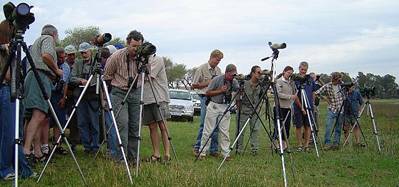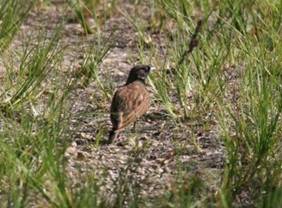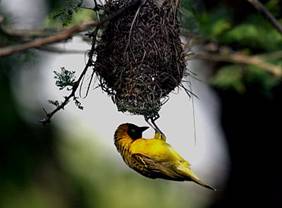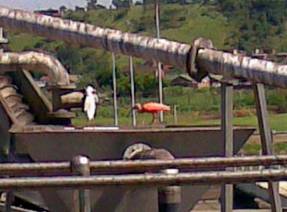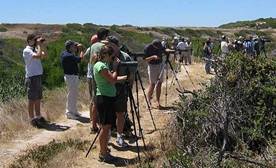SA Rare Bird News Report - 26 November 2009
Trevor Hardaker
|
|
|
|
S O U T H E R N A F R I C A N R A R E B I R D N E W S R E P O R T |
|
|
|
|
|
|
|
|
|
|
|
This is the Southern African Rare Bird News Report issued at 22h00 on Thursday, 26 November 2009. Information has been gleaned from various websites, email groups as well as from individual observers who have passed on their sightings. This report cannot be taken as being totally comprehensive as it is based only on information made available at the time of writing. All bird sightings reported here are reported in good faith based on information as provided by the observers. Any inaccuracies are totally unintentional and the writer cannot be held liable for these. For those who may have only joined the group recently and are interested in finding out what has been seen in the past, previous reports can be viewed at http://groups.google.co.za/group/sa-rarebirdnews |
|
|
|
|
|
Well, the odd movements of common species elsewhere in the country continue to surprise the birders in the Western Cape. The pair of LESSER STRIPED SWALLOWS first reported from De Hoop Nature Reserve on 16 September 2009 are still present and giving provincial twitchers more than ample opportunity to get down to the reserve and add them to their provincial lists. The birds are hanging around alongside the vlei and are most often seen in the vicinity of the rondavels or at the pool area. Equally of interest at De Hoop is what seems to be an influx of NAMAQUA SANDGROUSE into the area with a number of recent sightings.
Not too far east of here, the Bontebok National Park has also turned up some rather odd visitors in the form of a pair of KORI BUSTARDS. With a single bird being regularly reported in the Agulhas-Elim area over the last couple of months, are we seeing another irruption of this species into the southern part of the province as well?
The odd records continue with yet another FORK-TAILED DRONGO record, this time from Altydgedacht Farm in the Durbanville area. Other “dryland” birds that seem to be invading the Cape Town region at the moment include NAMAQUA DOVES with the furthest south sighting on the Peninsula so far received being of a single bird flying across the M3 into the Pollsmoor fields near Tokai on Monday. Interestingly, this species also seems to be irrupting on the south coast with 2 individuals noted in Nature’s Valley village on the weekend as well. A single FULVOUS DUCK was also present at Milnerton (Potsdam) Sewage Works yesterday.
Down on the Garden Route, there have also been several interesting sightings with an AFRICAN PALM SWIFT (possibly even 2 individuals) present at the Ebb ‘n Flow campsite in Wildernis National Park whilst a male BLACK-EARED SPARROWLARK looked rather out of place along the hiking trail which leads from the picnic site down into the Grootrivier Pass at Nature’s Valley. Not only is the latter record at least 100km further south than where it should normally occur (including several extensive mountain ranges in between that it would have had to have crossed), the fynbos-covered hillside on which it was seen is also rather atypical habitat...
In Kwazulu Natal, a pair of LESSER MASKED WEAVERS have been discovered breeding at Mount Edgecombe Estate in Durban and were showing well on Monday. They were apparently only discovered at this site last year for the first time and are evidently an extremely rare bird in the Durban area with not a single record during the first bird atlas project.
Also in the province, a RED-CRESTED KORHAAN was reported in the vicinity of Woodlands Lodge in Nambiti Game Reserve near Ladysmith at the end of last week. According to locals, the last time this species is noted in literature as being recorded in this general area was in 1980! |
|
|
|
|
|
|
|
|
Black-eared Sparrowlark in Nature’s Valley © Jacques Malan |
Lesser Masked Weaver at Mount Edgecombe © David Allan |
|
|
|
|
In Mpumalanga, an AFRICAN EMERALD CUCKOO was reported from riverine thickets alongside the Nyamundwa Dam on the S1 Doispane road in the Kruger National Park on Monday. Although there are previous records from the southern half of the park, this appears to be the first record since the inception of the second bird atlas project (which has already been running for about 2,5 years).
Moving into the North-west Province, the group of AFRICAN OPENBILLS reported from the Potchefstroom area recently are still present with at least 15 birds taking up residence in the OPM Prozesky marshland just south of the golf course in Potchefstroom. It is suspected that these birds are roosting in the Willow trees alongside the Mooi River. |
|
|
|
|
|
Of unknown origin, and presumed to be escapees, the female BLACK-CASQUED WATTLED HORNBILL originally reported from the Palmiet Nature Reserve in Kwazulu Natal in January this year and then at Umbogavango, near Amanzimtoti, in February and which resurfaced in Winklespruit, Warner Beach 10 days ago is still on the move and has now been picked up in Pennington, some 30-40km further south down the coast from Winklespruit. Also in the province, a SCARLET IBIS has been present at Darvill Bird Sanctuary in Pietermaritzburg this week. The closest known captive population of this species is at Umgeni River Bird Park in Durban which is some 80km away. |
|
|
Scarlet Ibis at Darvill Bird Sanctuary © Mark Brown |
|
|
|
|
|
It seems we are not the only part of the world that is currently experiencing really odd occurrences of birds. Perhaps the El Nino is really having some serious effect on the world’s birds at the moment? And hopefully, we can look forward to a bumper rarity season ahead filled with lots of odd and out-of-range birds turning up…
Below is an extract from an email I received from avid British twitcher, Lee Evans, about the occurrence of a Black-bellied Storm Petrel in the UK yesterday:
Bristol birder John Martin was birding Severn Beach for the third day running due to the storm-like conditions of recent days in the Bristol Channel. He was also joined by four birders from the Wolverhampton area who were keen to see a Leach's Petrel. At around 0820 hours in a fierce Force 6-7 SW gale, an odd petrel was picked up hugging closely the east shore of the Severn, 150 yards south of the southernmost Severn bridge crossing. It was Leach's Petrel-sized but significantly, had striking white underparts and axillaries and underwing-coverts. There was little forking in the tail and its flight was gliding, erratic and low to the sea. It was blackish above, with an obvious white rump, and generally all-white below but with some hint of a thin blackish stripe from the black upper breast to the blackish undertail-coverts. The upperparts were similar in pattern to a typical Leach's, with whitish fringes and tips appearing as a pale diagonal bar on the inner wing from the carpal joint to the trailing edge. However, at long range, this pattern was not visible and it appeared all dark on the upperparts. When flying away, the white rump was very obvious. There was perhaps a slight projection of the feet beyond the tail but this feature was hard to see in the blustery conditions. It was either a BLACK-BELLIED STORM PETREL Fregatta tropica or a WHITE-BELLIED STORM PETREL Fregatta grallaria.
It remained on view at very close range for about 15 minutes, gradually getting further and further away and being pushed with the incoming tide towards the bridge parapets. It was lost from view at about 0835 hours, just five people witnessing the unique event.
John quickly got the news out as widely as he could and with the knowledge that the tide still had three more hours to come in and this was generally the optimum period for petrel displacement in high winds, birders from the local area quickly descended on the site. The South Atlantic waif must have been sat on the sea for some time as at 0934 hours, it was glimpsed in line with bridge parapet 43 flying back out and battling its way with the wind south. It continued in a line just east of the two marker buoys mid-river being attended by four Herring Gulls which were taking an interest in it. By this time, a crowd had gathered and although very distant by now, a further 14 observers successfully managed to divert their scope lenses on the storm-tossed waif, keeping on it for just over four minutes before it dropped down on the sea at 0939 hours. The Herring Gulls were still surrounding it at this time and wit the knowledge that at least 3 of the morning's Leach's Petrels were killed and eaten by gulls, it is not known if this is what happened to it. Despite a constant vigil at the exact area in which it was seen to drop down, it was not seen again, and whether or not the strong tidal surge swept it upriver is unknown. In addition to the original five observers, the later 14 included Mark Ponsford, Gary Thoburn, Chris Craig, Rupert Higgins, Dick Reader, Paul Marshall, Brian Lancastle and David Gibbs.
Sadly, not one image or video was obtained during the two sequences of observation.
A total of 140 observers eventually arrived at the scene, from as far afield as Lancashire, Kent and Norfolk, but despite an all-day vigil until dusk, no more was to be seen of the bird. A total of 14 Leach's Petrels was seen, along with 93 displaced Kittiwakes, a sub-adult Pomarine Skua, a Little Auk and a Grey Phalarope.
Black-bellied Storm Petrel breeds in the South Shetlands, Elephant Island, South Orkneys, South Georgia, the Tristan de Cunha group and Gough Island, Prince Edwards, Crozets, Kerguelen, Antipodes and Auckland, with a total population of some 150,000 pairs. It is nowhere abundant but disperses in winter north to subtropical and tropical waters of all the three oceans and reaches the Northern Hemisphere in the Atlantic and Indian Oceans. There are four records for example off Cape Hatteras in North Carolina.
There has been one previous record in Britain - a Black or White-bellied Storm Petrel seen off Sheringham (Norfolk) on 10 December 2007 (Kevin Shepherd). |
|
|
|
|
|
Don’t forget to send through your details to be included on the various listing clubs that are hosted at www.zestforbirds.co.za. This website also has an extensive rarities gallery that has many additional photos of a number of rarities that are mentioned in these reports. |
|
|
|
|
|
|
|
|
|
|
|
Thank you to all observers who have contributed their records. Please continue to send through any reports of odd birds as well as continued updates on the presence of rarities already previously reported, no matter how mundane you think they may be. Even if you think someone else has probably sent in a report, rather send the report yourself as well. The only way to improve this service and to make it as useful as possible to everyone is if it can be as comprehensive as possible. |
|
|
|
|
|
Kind regards Trevor |
|
|
------------------------------------------------------------------------
TREVOR HARDAKER Cape Town, South Africa
See my wildlife photos at www.hardaker.co.za
ZEST for BIRDS Trevor Hardaker and John Graham Pelagics, rarity photos, listing clubs and more
SA RARE BIRD NEWS Get the latest rarity news by joining at: http://groups.google.co.za/group/sa-rarebirdnews
----------------------------------------------------------------------- |
|
|
|
|

